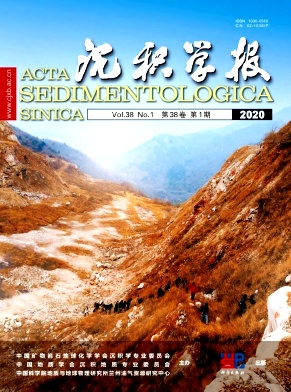HTML
-
二叠纪末大灭绝事件是地球生命演化过程中最为严重的一次生物灾难[1-2],近年来在灭绝事件之后浅海相地层中发现一套由微生物(蓝细菌等)作用而形成的微生物岩,这套钙质微生物岩沉积在我国华南地区广泛记录,其中广西白色地区作登剖面就发育有完好的微生物岩[3-5]。二叠纪末微生物岩由钙质微生物形成,其中还混生大量的后生动物群落,这个特殊的生物沉积建造反应了大灭绝后特殊的环境和生态组成特征[4, 6]。前人围绕微生物岩的形成和类型,以及地球生物学过程展开了大量的研究工作[3, 7-18]。但针对微生物岩微观沉积过程的研究相对较少。本文对作登剖面微生物岩中的凝块石进行详细的沉积学研究,通过显微镜观察,阴极发光背散射照片以及探针研究,探讨该微生物岩的沉积成岩过程。
-
作登剖面位于广西百色地区作登乡登高村,古地理位置上属于南盘江盆地内的孤立台地[19]。二叠纪—三叠纪之交,南盘江盆地内沉积连续的碎屑岩沉积,而盆地内孤立碳酸盐台地则沉积连续碳酸盐岩沉积[20](图 1)。二叠纪末大灭绝事件后,微生物岩发育在这些孤立的碳酸盐岩台地之上[3, 8, 21-23],作登剖面就位于德宝孤立碳酸盐台地之上[24]。作登剖面微生物岩直接沉积在二叠纪生物碎屑灰岩之上,微生物岩和生物碎屑灰岩之间存在一个不规则的接触关系,前人研究认为该不规则面可能代表海底溶蚀[25-26]或者暴露风化[27-29]的过程。

Figure 1. (a) Geographical map of China showing the Nanpanjiang Basin region. (b) Paleogeographical map showing the Nanpenjiang Basin, isolated platform within the basin and adjacent Yangtze Platform during the Lower Triassic (modified from Lehrmann et al. [21]). Note the Zuodeng section located at an isolated platform within the Nanpenjiang Basin. (c) Columnar section of the P-Tr succession exposed at the Zuodeng section. The PTB extinction event horizon is marked by the last occurrence of diverse Permian fauna at the top of skeletal packstone of the Heshan Formation. PTB is placed at the upper part of the microbialite deposit due to the first appearance of Hindeodus parvus ("←" represents the location of the end-Permian mass extinction)
作登剖面生物碎屑灰岩中保存大量的有孔虫和钙藻化石,有孔虫包括䗴类有孔虫Palaeofusulina sinse 和非䗴有孔虫Colaniella sp.,这类化石组合时代为华南地区典型的晚长兴阶[26, 30-31]。
作登微生物岩主要由底部叠层石和上部凝块石组成[5]。凝块石野外为微斑状结构,由微晶方解石和粗晶方解石组成(图 2)。微生物岩内发现的Gakhum-ella微生物化石与其他微生物岩剖面一致[3-4, 6](图 3)。凝块石在微生物岩底部块状构造,在微生物岩顶部出现穹窿状构造,在凝块石穹窿构造之间发育有大量的介壳沉积。凝块石内发现大量的微小腹足类,双壳类,介形虫,有孔虫以及蠕虫虫管化石,这些化石组合和底部二叠纪生物面貌完全不同[3-4]。在微生物岩的底部发现了牙形石Hindeodus parvus [32],表明微生物岩时代属于早三叠世。此外,作登剖面碳同位素的研究显示,无机碳同位素的最大负偏也是从微生物岩底部开始[33]。

Figure 2. (a) Field photograph showing features of thrombolites in Zuodeng; (b) Thin-section photomicrograph under plane light microscope showing clotted textures of thrombolites in the Zuodeng microbialites. The yellow circles indicate ostracoda fossils; (c) Photomicrographs of thrombolites in transmitted cathodoluminescence (TCL) images; (d) Photomicrographs of thrombolites in backscattered electron images

Figure 3. Microfossils preliminarily identified as Gakhumella calcimicrobe in thrombolites in the Zuodeng section
作登微生物岩之上为一层黄色的泥岩,泥岩之上为薄层的微晶灰岩(如图 1岩石地层柱状图)。在泥岩和薄层灰岩中没有发现化石。
-
野外对岩石样品进行定向采样,室内进行岩石薄片、探针片和光面制作。运用Leica DM2500p偏光显微镜、Technosyn Model 8200 Mark V型阴极发光仪(工作电压为12 kV,工作电流为200 μA)对岩石薄片进行阴极发光显微观察。对岩石探针片进行背散射成像,确定其矿物相组成。背散射实验在中国地质大学(武汉)生物地质与环境地质国家重点实验室的日立SU8010型场发射扫描电子显微镜下完成。通过日本电子JEOL JXA-8100型电子探针(EPMA)测试岩石中Sr,Mn,Fe,Mg,S,Al,Ca,Mg的浓度。电子探针工作电压为15 kV,束流为20 nA,束径为3~10 μm。检测限通常低于500×10-6,分析精度优于一个相对百分含量。
-
凝块石野外呈现斑状结构,由暗色粗晶和浅色微晶组成(图 2a)凝块石镜下明显分为两个部分,浅色粗晶颗粒和暗色微晶颗粒,呈现斑块状结构(图 2b)。
镜下观察显示,粗晶部分主要为方解石晶体颗粒,而细小的微晶颗粒主要为白云石组成。粗晶方解石表面以及孔隙中分布菱形白云石。
在深色微晶内发现微小腹足类,双壳类、蠕虫虫管、介形虫和有孔虫化石(图 2),而被认为可能是Gakhumella微生物化石主要出现在粗晶中[3-5](图 3)。
-
凝块石阴极发光照片显示三种明显的发光特征(图 4)。粗晶部分阴极发光弱,显示为暗色(图 4中Ⅰ),其与微晶接触边界显示为丛状特征(图 4b,h),在其中可以看到规则的管状的发光;微晶部分阴极发光中等,表现为无发光到红色发光特征(图 4中Ⅱ);而菱形的白云石阴极发光强,表现出强烈的红色发光特征(图 4中Ⅲ),白云石也显示环带的发光特征。

Figure 4. (a)(d)(g)(j) Photomicrographs of thrombolites in transmitted light in the Zuodeng section; (b)(e)(h)(k) Photomicrographs of thrombolites in cathodoluminescence (CL) images in the Zuodeng section; (c)(f)(i)(l) Photomicrographs of thrombolites in CL images after revision
Gakhumella微化石和介形虫等化石壳体阴极发光弱(图 4h)。
海相碳酸盐的成岩过程伴随对Mn、Fe元素的吸收过程[34],而碳酸盐岩的阴极发光特征与Mn、Fe含量相关[35-37]。碳酸盐岩中的沉积、成岩组分往往显示不同程度的阴极发光特征,因此海相碳酸盐矿物的阴极发光性也成为判断其成岩蚀变强度的有效方法之一[38-40]。
作登剖面凝块石中三种不同阴极发光特征说明了在其沉积成岩过程中不同的层次,为重新还原其沉积成岩过程提供了依据。
-
凝块石背散射照片也显示了三个不同等级的灰度(图 5)。粗晶为浅灰色,晶体多显示为无定形(图 5中Ⅰ),连成片状,与微晶交界处也表现出丛状特征(图 5c);微晶则为灰黑色,晶体颗粒感明显(图 5中Ⅱ);菱形的白云石则显示出黑色(图 5中Ⅲ),点状分布在粗晶和微晶中。
凝块石中介形虫化石壳体背散射为灰黑色,壳内晶体为灰色(图 5)。Gakhumella微化石也为灰黑色。
背散射照片灰度变化主要和矿物类型有关,作登剖面凝块石中三种不同的背散射灰度特征中,表现出灰色特征主要为方解石颗粒,而黑色主要是白云石颗粒,依据颗粒大小将白云石颗粒分为了Ⅱ和Ⅲ。
-
探针测试显示,微晶中Fe平均含量明显高于粗晶,其平均含量达到34 325×10-6,微晶中Mg,Al,Si,S含量也明显高于粗晶,分别为69 647×10-6,7 635×10-6、24 272×10-6和325×10-6(表 1)。微晶元素含量特征与白云石总体一致。
Ca Mg Fe Mn Al Si S Sr 微晶 247 504 69 647 34 325 138 7 635 24 272 325 481 粗晶 351 086 24 644 372 102 4 889 14 231 188 516 白云石 233 880 101 516 28 695 221 3 977 6 585 431 386 介形虫化石 396 767 3 596 90 51 25 167 139 362 微化石 212 569 62 668 1 607 235 13 160 50 198 2 843 731 Table 1. Average element content in different parts of the thrombolites in the Zoudeng section (×10-6)
对凝块石中的Gakhumella微化石和介形虫化石的元素分析显示,两者特征明显不一样。Gakhumella微化石中Mg、Fe、Al、Si和S均远高于介形虫化石中这些元素的含量。
元素投点图明显显示了这个特征,微晶中Si,Fe,Al含量明显高于粗晶(图 6a,b,d)。粗晶中Mg含量分布范围较大(图 6c),部分Mg含量与白云石一致,显示粗晶中包含了白云石颗粒。
同为化石,介形虫和Gakhumella微化石之间元素组成上明显存在区别,Gakhumella微化石元素组成分布完全不同于介形虫。
3.1 微相特征
3.2 阴极发光特征
3.3 背散射特征
3.4 元素分布特征
-
Kershaw et al. [13]研究中四川地区微生物岩,还原了微生物生长特征与成岩后的结构特征之间关系,从中观尺度解释了微生物岩呈现出斑状,穹窿状的结构构造特征。而对于微生物岩的沉积成岩过程没有讨论,本文对微生物岩中生物化石分布、矿物类型、以及元素含量特征的分析,从微观尺度探讨微生物岩的沉积成岩过程。
凝块石岩石特征,阴极发光以及背散射特征显示出三种不同的晶体形态和发光特征,这些特征记录了凝块石的沉积成岩过程。元素含量分析显示了不同部分的可能沉积矿物类型。
依据这些特征,按照碳酸盐岩沉积特征,将凝块石的沉积成岩过程总结为以下四个阶段:
(1)凝块石生长阶段,由大量微生物和沉积物形成的生物建造,如图 7a,其中绿色部分代表了微生物,周围深色部分代表了海水和沉积物。在凝块石薄片中,钙质微生物主要出现在粗晶区域(图 3),而腹足类,有孔虫等多出现在微晶区域(图 2b、图 5b),微晶中探针测试显示Si、Al含量相对其他区域高(图 6),说明该处以沉积的黏土矿物为主。

Figure 7. Sketches of thrombolites in the Zuodeng section: (a) growth stage; (b) accumulation stage; (c) early diagenetic stage; (d) late diagenetic stage. For detailed explanation, see text
(2)凝块石的埋藏阶段,随着沉积物增加,微生物周围被沉积物充填,微生物停止生长,如图 7b,深色沉积物充填孔隙。
(3)凝块石早期成岩阶段,微生物代表的有机质部分钙化,如图 7c蓝色部分。凝块石的斑块结构是该阶段重要产物。
(4)凝块石后期成岩阶段,在埋藏成岩后,白云石化过程开始,在微晶内,岩石孔隙中白云石大量形成(图 7d)。在阴极发光和背散射照片中可以发现大量的白云石颗粒(图 4, 5)。
-
作登剖面凝块石在镜下呈斑状结构,粗晶部分主要为方解石晶体颗粒,微晶部分主要由白云石组成,并且粗晶方解石表面及孔隙中分布有菱形白云石。微晶内发现微小腹足类,双壳类、蠕虫虫管、介形虫和有孔虫化石,而Gakhumella微生物化石主要出现在粗晶中。
凝块石背散射矿物相、阴极发光特征和元素探针分析显示了凝块石成岩过程中的三个不同期次。通过对凝块石中化石的分布,矿物组成以及元素分布规律进行观察,对比现代凝块石沉积成岩过程,总结了二叠纪—三叠之交凝块石的沉积成岩过程包括:早期生长阶段,沉积阶段,早期成岩阶段和后期成岩阶段。









 DownLoad:
DownLoad:





